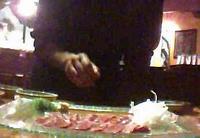 日本的科學性捕鯨計畫一直備受爭議,一個由科學家、環保主義者以及記錄片製片人所組成的國際研究小組,在加州洛杉磯以及韓國首爾等地的壽司店,揭發了一項與此有關的鯨魚肉非法貿易。
日本的科學性捕鯨計畫一直備受爭議,一個由科學家、環保主義者以及記錄片製片人所組成的國際研究小組,在加州洛杉磯以及韓國首爾等地的壽司店,揭發了一項與此有關的鯨魚肉非法貿易。
經過遺傳分析後證實,奧斯卡獲獎紀錄片《血色海灣》(譯者按:台灣將於5月7日上映)電影製片人2009年10月在洛杉磯壽司店所購得的生魚片,來自瀕臨滅絕的塞鯨。
塞鯨(Balaenoptera borealis)以及其產製品是華盛頓公約(CITES)中,禁止國際貿易的物種,塞鯨同時也是IUCN紅皮書中生存受威脅的瀕危(EN)物種。
美國奧勒岡州立大學的科學家進行了DNA分析後說,在這間名叫駝峰(The Hump)的餐廳所供應的鯨肉,很有可能來自日本的「科學捕鯨計畫」。
「自從1986年國際暫停商業捕鯨之後,除了日本,沒有其他已知的塞鯨供應來源。」執行DNA分析的奧勒岡州立大學海洋哺乳動物研究所副所所長貝克(Scott Baker)說。「這突顯了鯨肉產品非法國際貿易的現實問題。」
最初發現這樁非法貿易的是紀錄片《血色海灣》導演賽侯尤斯(Louie Psihoyos)與副導演漢布爾頓(Charles Hambleton),他們在駝峰餐廳內秘密拍攝所其供應的鯨魚肉。
貝克表示,取自駝峰的樣本無法確認是來自單一鯨魚個體,因為日本政府並沒有公佈科學捕鯨樣本的遺傳資料。
貝克與10名共同作者,包括《血色海灣》製作人,在他們發表的論文中要求日本,公佈科學捕鯨以及鯨魚混獲所取得的DNA紀錄。所謂的「混獲」指的是漁船非刻意捕捉到非目標漁獲的情形。
「過去幾年以來,我們利用遺傳學作為工具,來監測全世界鯨魚族群的能力,已有顯著的提升。」貝克說,「但除非我們能取得包括日本科學捕鯨的所有數據,我們無法提供資源管理者最佳的科學依據。」
壽司是由鯨魚生魚片所製成的。由貝克與奧勒岡州立大學的史提爾(Debbie Steel)所進行的遺傳學檢測中發現,有4個樣本來自南極小鬚鯨,4個樣本來自塞鯨,3個樣本來自北太平洋小鬚鯨,1個來自長鬚鯨,1個來自花紋海豚。
長鬚鯨(Balaenoptera physalus)以及其產製品的國際貿易目前也受到華盛頓公約所禁止,並且名列於IUCN紅皮書中受威脅的瀕危(EN)物種。
其他的鯨魚與花紋海豚目前則未受保護。
在首爾餐廳所購買的長鬚鯨肉與貝克同事舟橋直子(Naoko Funahashi)2007年在日本市場所取得的鯨肉,經過DNA特徵比對後證明,非常有可能來自同一隻鯨魚。
「由於國際暫停捕鯨,所以我們假定不會有鯨魚產品的國際貿易,」貝克說。「而當同一隻鯨魚的製品分別在2007的日本與2009年的韓國銷售時,表示仍然存在有違法的國際貿易問題。」
「同樣的,南極小鬚鯨並沒有在韓國水域中發現,卻是經由日本在南極的爭議性科學捕鯨所捕獲,它怎麼會出現在首爾的餐館?」他問道。
貝克在全世界市場鯨魚產品原產地方面的研究已經享譽國際,他與賽侯尤斯和漢布爾頓合作,在《血色海灣》一片中,描述了海豚肉受到高濃度汞所污染的研究。
他們的報告以蘇聯在20世紀中,超過10萬隻未登錄的捕殺紀錄做為開頭,作者們描述了長久以來偽造的鯨魚捕撈紀錄。他們說,這非法、未通報與不受管制的捕鯨行為,「在今天仍以混獲和科學捕鯨之名持續進行著。」
An illegal trade in whalemeat, linking whales killed in Japan's controversial scientific whaling program to sushi restaurants in Los Angeles, California and Seoul, South Korea, has been uncovered by an international team of scientists, documentary filmmakers and environmental advocates.
Genetic analysis of sashimi served at a Los Angeles sushi restaurant in October 2009 has confirmed that the pieces of raw meat purchased by filmmakers of the Oscar-winning documentary, "The Cove," came from an endangered sei whale.
International trade in sei whales, Balaenoptera borealis, and their parts is banned by the Convention on International Trade in Endangered Species. and sei whales are listed as Endangered on the authoritative IUCN Red List of Threatened Species.
The Oregon State University scientist who conducted the DNA analysis says the whale meat served at the restaurant, called The Hump, most likely is a product of Japanese "scientific whaling."
"And since the international moratorium on commercial hunting (1986), there has been no other known source of sei whales available commercially other than in Japan," Baker said. "This underscores the very real problem of the illegal international trade of whalemeat products."
The illegal trade was first uncovered by "The Cove" director Louie Psihoyos and assistant director Charles Hambleton who covertly filmed the serving of whale products at The Hump restaurant.
Baker said the samples taken from The Hump cannot conclusively be linked to an individual whale because genetic identity records of animals killed through Japan's scientific whaling are not released by the Japanese government.
In their paper, Baker and 10 co-authors, including "The Cove" filmmakers, call for Japan to share its DNA register of whales taken from that country's scientific whaling program and "bycatch" whaling. Bycatch is the unintentional capture of non-target species by fishing vessels.
"Our ability to use genetics as a tool to monitor whale populations around the world has advanced significantly over the past few years," Baker said, "but unless we have access to all of the data, including those whales killed under Japan's scientific whaling, we cannot provide resource managers with the best possible science.
The sushi was part of a mixed plate of "whale sashimi." Genetic testing by Baker and OSU's Debbie Steel determined that four of the products were from an Antarctic minke whale, four were from a sei whale, three were from a North Pacific minke whale, one was from a fin whale, and one was from a Risso's dolphin.
International trade in fin whales, Balaenoptera physalus, and their parts is also prohibited by the CITES treaty, and fin whales are listed as Endangered on the IUCN Red List of Threatened Species.
The other whales and the Risso's dolphin are not protected species.
The DNA profile of the fin whale meat from the Seoul restaurant genetically matched products purchased by Baker's colleague, Naoko Funahashi, in Japanese markets in 2007, strongly suggesting it came from the same whale.
"Since the international moratorium, it has been assumed that there is no international trade in whale products," Baker said. "But when products from the same whale are sold in Japan in 2007 and in Korea in 2009, it suggests that international trade, though illegal, is still an issue.
"Likewise, the Antarctic minke whale is not found in Korean waters, but it is hunted by Japan's controversial scientific whaling program in the Antarctic. How did it show up in a restaurant in Seoul?" he asked.
Baker has developed an international reputation for his research in determining the origin of whalemeat products sold in markets around the world. His research on identification of dolphin meat contaminated with high levels of mercury was featured in "The Cove," where he worked with Psihoyos and Hambleton.
In their paper, the authors describe the long legacy of falsifying whale catch records, beginning with the Soviet Union, which failed to account for more than 100,000 whales it killed in the 20th century. They say this illegal, unreported or unregulated whaling "continues today under the cover of incidental fisheries bycatch and scientific whaling."







